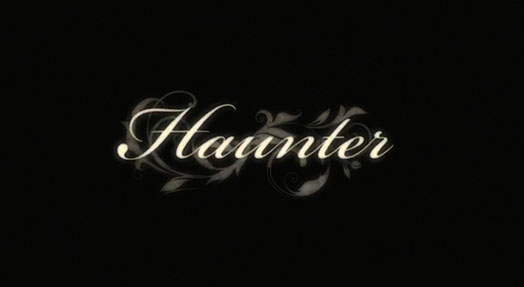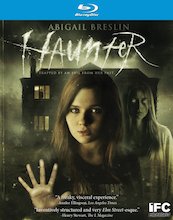
 BUY FROM AMAZON: CLICK HERE!
BUY FROM AMAZON: CLICK HERE!
MSRP $29.98
RATED UR
STUDIO MPI Home Video
RUNNING TIME 97 Minutes
SPECIAL FEATURES
• Director Commentary
• Writer Commentary
• The Complete Storyboards
• Behind-the-Scenes Featurette
• Teaser Poster
• Trailer
The Pitch
Like Groundhog Day meets The Others meets Beetlejuice meets Insidious, but a lot less than the sum of its parts.
The Humans
Abigail Breslin, Stephen McHattie, Vincenzo Natali, Peter Outerbridge
The Nutshell
Life is boring for Lisa (Abigail Breslin). She’s stuck inside her house, endlessly re-living the same Sunday with her family over and over again. Lisa starts to notice strange noises and frightening apparitions, and eventually encounters an evil spirit (Stephen McHattie) who seems to be the mastermind behind her family’s imprisonment.

“Momma says my face gon’ stay like this until I get kicked again by the same horse.”
The Lowdown
Back in March when RogerEbert.com’s Matt Zoller Seitz (who has actually made a movie) bemoaned the lack of technical talk in film criticism, I took it to heart. Many of today’s internet film critics seem to lean heavily upon the narrative, and don’t devote nearly as much time to talking about the technique and craft of filmmaking. I’d link to another critic’s recent review to demonstrate why I say that, but I don’t want to talk shit about other writers. Instead, you can look back at my review history, and see that I’ve written some reviews that focus almost entirely on what happened in the film, not the filmmaking on display.
You could argue that all the details of the filmmaking process are actually in service of the narrative, and that theory is true to some extent. The donuts at the craft service table fuel the gaffer. The gaffer makes sure the set and performers are lit. The lighting conveys the mood. The mood ends up on the screen, and it helps tell the story. You could also say that some donuts helped make a movie, but that’s not important.
Really, all I’m saying is this: what merits some discussion is how the placement of those lights helped make the movie, and how you can use things like light to make an audience feel something. There’s plenty of people who won’t be interested in reading stuff like that, and that’s okay. After all, there’s a reason why so many sites do recaps (not reviews) of TV episodes: people want to read about stories.

“Honey, it’s that Jones kid from next door, he wants to talk about math homework.”
But stories are inherently formulaic, so telling a story that is both inventive and satisfying isn’t easy. Just take a look at some of the more inventive narratives in recent memory: Only God Forgives, Under The Skin, Holy Motors, Spring Breakers, Inside Llewyn Davis, The World’s End… each one boldly risks audience dissatisfaction in order to tell a unique and impactful narrative. I know some of you hated these movies because of their stories, but you can’t deny that even if you hated it, at least it had an impact.
I didn’t hate Haunter, but my general dislike of the film does stem from Brian King’s screenplay, and its inability to create impact. This puts me in a predicament, because on a technical level, Haunter is fairly competent, the performances are just okay, and I don’t have much to say about the filmmaking. Vincenzo Natali, writer/director of Splice (which I enjoyed), has proven himself very capable in the director’s chair, particularly in the current season of NBC’s Hannibal. His work on Cube showed that he could shoot a low budget sci-fi horror in one room and somehow make it feel like something grander. While Haunter is certainly low budget filmmaking, Natali does his best to make sure the film doesn’t look ugly or cheap. There are still some entire sequences that don’t hold up (particularly when visual effects and green screen are used) and if you listen to his commentary on the disc, Natali knows exactly which sequences they are and why they look like shit. So Natali, while he didn’t pick a good script with Haunter, takes little of the blame for why it fails.

“Candygram.”
Haunter fails as a horror film, because it feels like horror lite. Diet horror. It isn’t remotely frightening, because if you read the back of the Blu-Ray case, you’d know that Lisa and her family are all dead. They can’t be threatened with their lives or safety. The kind of stakes that are present in any slasher film aren’t anywhere to be found here. Both the protagonist and villain are ostensibly invincible, which worked in Beetlejuice but only because we cared about what happened to Lydia. Lydia developed a real emotional connection with The Maitlands, which gave the film its stakes. There’s a living family at risk in Haunter, but we never come to care about them. We just know that Lisa wants to spare them her fate, which is nice, I guess.
Another striking similarity to Beetlejuice is that Lisa and her family are doomed to spend eternity stuck in their house, repeating the same Sunday again and again. This is a deceptively complicated premise. When Lisa tries to leave the house, she ends up in the dense fog that surrounds the house (reminiscent of The Others), but eventually ends up right back where she started. Her family’s looping reality is frequently disrupted with no apparent narrative logic, and because Lisa is the protagonist, she’s the only one who seems to notice or care that every day is exactly the same, except for the apparitions that appear at random to advance the plot, the odd noises in the basement, or when her father suddenly acquires and loses a smoking habit.
Why is Lisa the only one who notices these “glitches” in her reality? It’s an easy answer: she’s the protagonist. It’s not like she’s “The Chosen One” or anything. In fact, she’s not special at all. I’m not saying that all protagonists have to be “special”, but this is a classic case of plot motivated by plot alone, and instead of being motivated by character. I suppose you could say Lisa is curious, and her curiosity propels the plot, but it’s not like she inherently possesses more curiosity than anyone else in the film. She’s just your average teenage girl, and there’s really no reason for her to be this story’s protagonist other than the writer wanting it that way. There’s also no moment when Lisa realizes that her life has begun to loop. By the time the film begins, Lisa already knows this, but instead of letting the audience figure out that something is off, Lisa just tells us that she’s the only one who notices, and that she suspects they’re all dead.

Lucky Strike: It’s toasted!
We don’t ever learn the rules or logic behind Lisa’s spiritual/temporal imprisonment. She was put there by an evil ghost who can pop in and out at will, and while we know Lisa will have to defeat the evil ghost, the film never sets up a clear path for her to do so. So when it comes time for the film to end, it results in a puzzling deus ex machina that makes so little sense it’ll leave you reeling.
In our story-obsessed culture, it’s movies like Haunter that get forgotten, not because they’re technically deficient, but because they display a fundamental misunderstanding of what makes characters identifiable and stories engaging. You can see why critics might skimp on the technical details when a script is as poorly structured as it is in Haunter.
The Package
The video quality on the disc is crisp and nearly free of artifacts, but the black levels are often grayish, making the film look cheap and washed out. Also, there is some horrendous banding (see screenshot below) during the scenes that take place in digital fog. They look bad enough that they affect the production value of the film.

Boy, weather sure looks shitty today.
The DTS-HD MA 5.1 audio track is a bit more satisfying, with a good bit of bass rumble and frequent use of the rear channels. The handful of extras are the single best thing about the disc, though. Vincenzo Natali’s commentary is really enlightening, and reveals just how creative you have to get to finish your low budgeted film. There’s a wide shot in the film that was literally accomplished with a Barbie doll standing in for Abigail Breslin, and I couldn’t tell how Natali had done it until he revealed it in the commentary. The track is filled with cool trivia like this, and if you can bring yourself to watch Haunter, Natali’s commentary is very insightful. Screenwriter Brian King’s commentary is quite good as well, and he talks at length about the evolution of the story through multiple drafts of the screenplay. The complete storyboards (drawn by Natali) are included on the disc, and they’re a great inclusion for film students. The behind-the-scenes featurette includes some good interviews, but is otherwise the standard kind of stuff we see all the time.
Rating: 




Out of a Possible 5 Stars